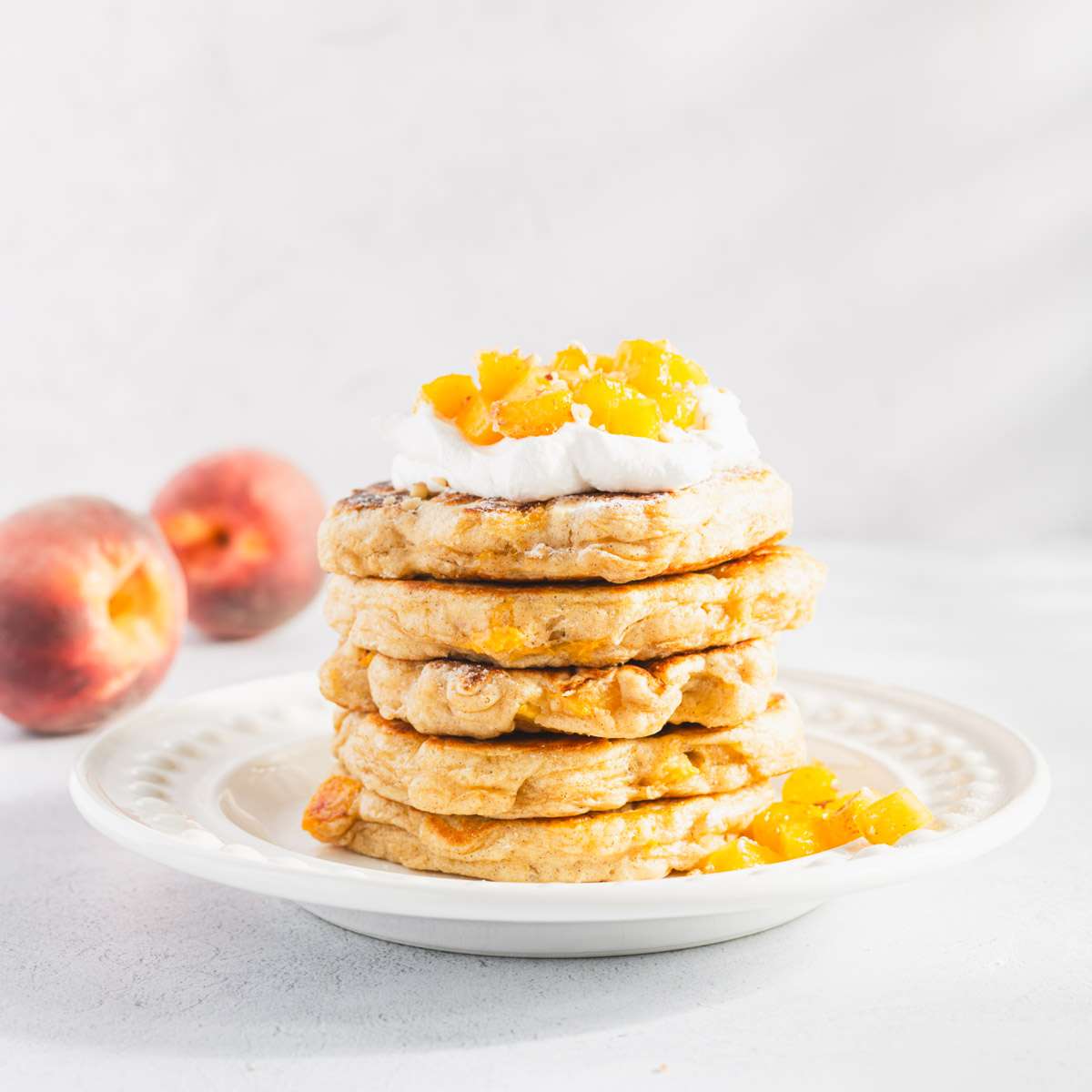Lemon Poppy seed Polish Babka
Polish babka is a traditional cake served on Easter, but being such a delicious treat, any occasion is great to make it. The taste and texture of this Lemon – Poppy seed Polish Babka is worth every minute of the 15 minutes of kneading. Yes, you see it right, 15-20 minutes of kneading. Of course you can use a stand mixer, but seeing the texture of the dough transform under your palms is very rewarding. Tune in a podcast or favorite audiobook and knead away.

This Lemon Poppy Seed Yeast Babka is easy to make and easy to customize.
I used golden raisins, but you can skip them and use dried apricots or other fruit. Poppy seeds are optional as well, omit or use chopped almonds for the extra texture and crunch.
Why you will love Polish Babka
Pillowy Texture – the most irresistible quality of yeast babka is its soft, pillowy texture. The magic of this yeast dough and kneading for 15 minutes creates a fluffy interior that practically melts in your mouth with each bite.
Versatility – this recipe is more than just an easy polish babka. Yeast babka is a blank canvas for flavor exploration. Whether you’re adding swirls of cinnamon-sugar, chocolate, or tangy citrus zest, there are endless possibilities.
Complex Flavors – rich dough and flavorful fillings, yeast babka offers a treat for your taste buds.
Satisfaction of homemade treat – from kneading the yeast dough to watching it rise and filling your home with aroma of freshly baked bread, the process is as rewarding as the end result.
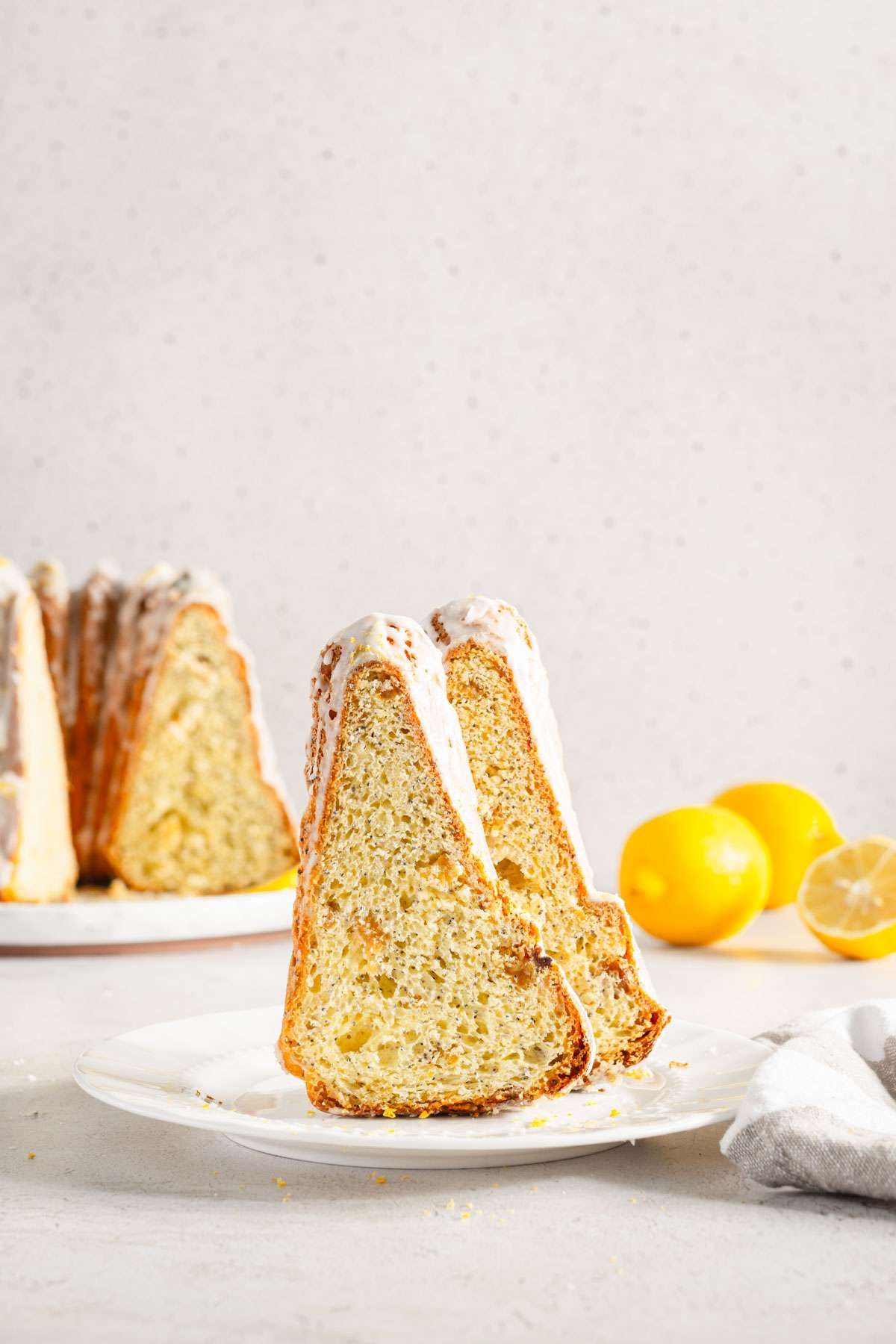
Ingredients, Variations and Substitutions


Golden Raisins – sweet, dried grapes with a golden hue. Soaking them will plump them up and will add moisture and flavor to the babka. You can use regular raisins or other dried fruits like currants, chopped apricots, or cranberries. If you prefer to avoid alcohol, you can soak the raisins in hot water, tea or fruit juice instead.
Rum or Brandy – used for soaking the raisins. The alcohol evaporates during baking, leaving behind the flavor without the alcohol content. You can substitute with fruit juice, tea or water for soaking the raisins..
Milk – heated to 100 -110F (38-43C) beside adding moisture and richness to the dough is needed to activate the yeast. You can use non-dairy milk alternatives like almond milk, soy milk, or oat milk if preferred.
Active Dry Yeast – a leavening agent that helps the dough rise. Make sure the yeast is fresh and active for optimal rising of the dough. If using instant yeast follow 1:1 ratio to substitute for active dry yeast. You may not need to proof instant yeast before adding them to the dough. If you have access to fresh yeast, you can use them instead (you will need about 40 g of fresh yeast).
Sugar – touch of sweetens for the dough. It is also recommended to use it to proof the yeast. You can use honey, maple syrup, or agave syrup as alternatives for granulated sugar.

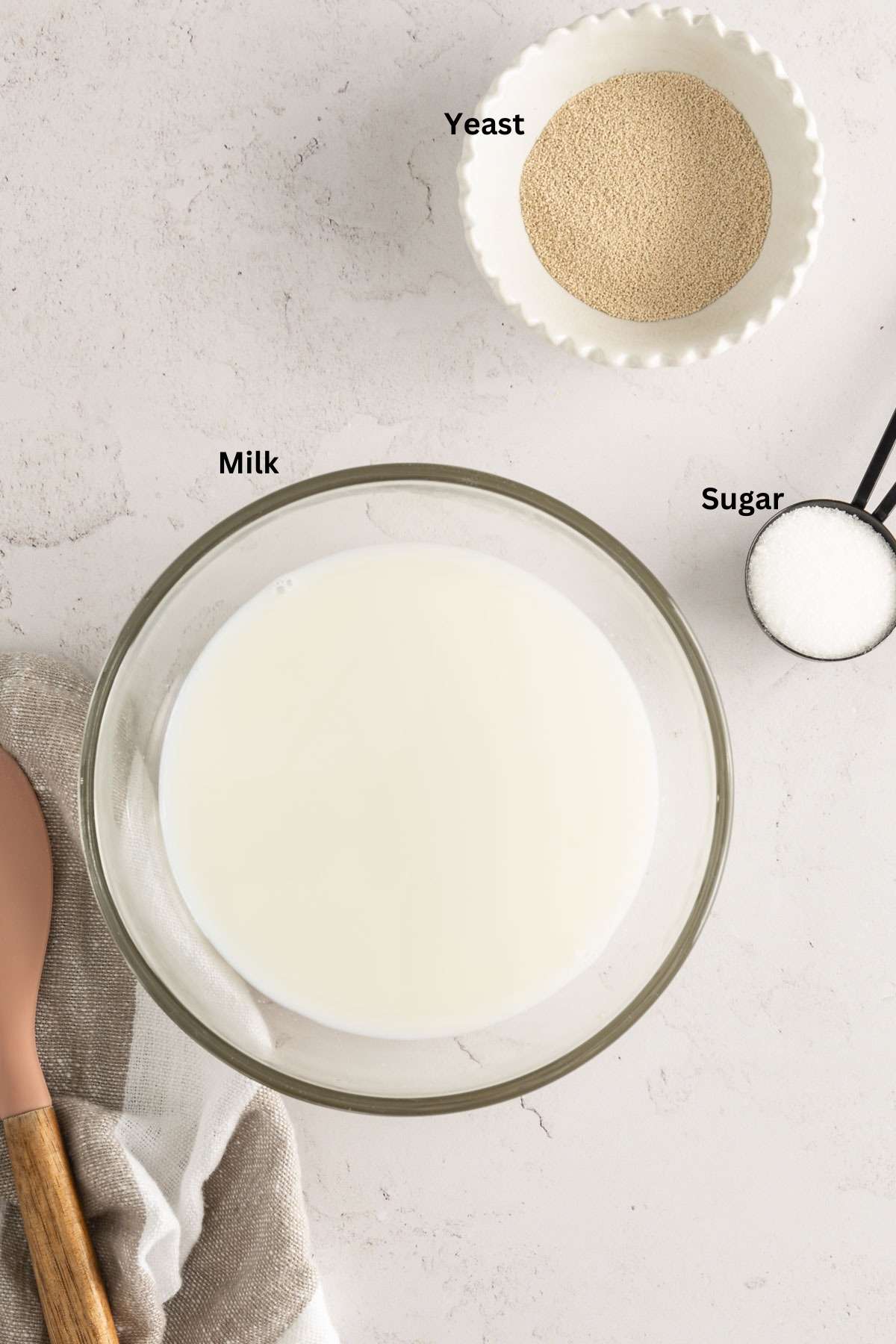
Vanilla Extract – adds an aromatic flavor to the dough. You can use vanilla bean paste or vanilla powder as alternatives to the vanilla extract. You can omit this ingredient if necessary.
Egg Yolks and whole egg – needed to create rich color, and structure to the dough. Egg yolks contribute to a tender crumb and help create a soft, moist texture in the finished babka. For each egg yolk, you can use 1 tablespoon of additional melted butter or 1 tablespoon of milk as a substitution. However, the texture and richness may be slightly different.
Lemon Zest – bright, citrusy element of the dough, balancing the sweetness with its tangy notes. You can use orange zest or lime zest as alternatives for lemon zest, depending on your preference.
Poppy Seeds – blue-black seeds with a nutty flavor and crunchy texture. Poppy seeds add visual interest and a subtle crunch to the babka. They also complement the lemon flavor beautifully. You can omit poppy seeds if desired or replace them with sesame seeds or chopped nuts for added texture.
Sea Salt – enhances flavor and balances sweetness. You can use table salt or kosher salt as alternatives for sea salt.
Flour – all-purpose flour is typically used for making babka. You can use bread flour for a chewier texture or whole wheat flour for a nuttier flavor. Keep in mind that substitutions may alter the final result, so adjust accordingly.
Butter – create rich, flavorful and moist dough. Melted butter gives the babka a tender, buttery crumb. You can use margarine or vegetable shortening as alternatives for butter, but they may affect the flavor and texture of the babka. I recommend unsalted butter over salted butter for this recipe as we will be adding salt separately.
Powdered Sugar – used for making a sweet glaze to drizzle over the baked babka. You can use granulated sugar blended into a fine powder using a blender or food processor.
Lemon Juice – provides acidity to balance the sweetness of the sugar glaze. You can use orange juice, milk or water as alternatives in the glaze.

Equipment you will need
- Mixing bowls
- Measuring cups and spoons
- Stand mixer with the dough hook; not essential but helps speed up the kneading process
- Bundt pan or loaf pan
- Cooling rack
- Kitchen towel or plastic wrap
- Citrus zester
Top tips for success with Yeast Babka
Use fresh Ingredients – especially eggs, yeast and citrus zest.
Proper yeast activation – so, so important! Ensure the yeast is properly activated before adding it to the dough. Use warm liquid (milk or water) and a small amount of sugar to activate the yeast. Mix in a medium bowl and keep in a warm place for 10-15 minutes. The mixture should be frothy, foamy and you definitely will be able to smell the yeast. If the liquid is too hot, it can kill the yeast.
Use room temperature ingredients – using cold ingredients can slow down yeast activity and hinder dough rise. Room temperature ingredients are ideal for yeast activation and dough fermentation.
Kneading technique – here is where you need some elbow grease 🙂 Knead the dough thoroughly until it becomes smooth and elastic. Proper kneading helps develop gluten, resulting in a light and airy texture in the finished babka. Use a floured surface and gentle pressure to knead the dough evenly.
Dough rising – equally important as blooming the yeast and kneading. Allow the dough to rise in a warm, draft-free environment until it doubles in size. Cover the dough with a clean kitchen towel or plastic wrap to prevent it from drying out during rising. The rising time may vary depending on factors such as room temperature and yeast activity.
Baking – preheat the oven before baking to ensure even heat distribution. Keep an eye on the babka towards the end of the baking time to prevent over-browning.
Cooling – just like with a steak, allow the babka to rest and cool in the pan for a few minutes before transferring it to a wire rack. This helps prevent the babka from sticking to the pan and allows excess moisture to evaporate.
Step by Step
- Prepare the raisins filling – add golden raisins and brandy to a small bowl. Stir well to combine. Finish by pouring hot water to cover the raisins fully. Let the raisins soak for at least 1 hour. Longer if possible.



- Activate the yeast – in a small bowl, combine warm milk, active dry yeast, and 1- 2 tablespoons of sugar. Stir gently to combine. Let it sit in a warm place for about 5-10 minutes until the yeast becomes foamy and fragrant. If using fresh yeast crumble it add to warmed milk along with 1 tsp of sugar.



- Drain the soaked raisins, discarding any excess liquid. Pat the raisins dry with a paper towel and set them aside. I also sprinkled the raisins with tablespoon of flour to further absorb any moisture. Shake off any excess of flour prior to adding it to the dough.



- Prepare the dough – In a large mixing bowl combine together flour, egg yolks, whole egg, granulated sugar, vanilla extract, lemon zest, poppy seeds, sea salt, activated yeast mixture, butter and raisins. Using your hands knead lightly to incorporate all the ingredients until soft dough forms.



- Knead the dough – transfer the dough to a floured surface and knead it for about 10-15 minutes until it becomes smooth and elastic. You can also use a stand mixer to speed up the process but it is not required.
- Fill the babka form – grease the babka baking form with butter. Transfer the prepared dough into the prepared pan, spreading it out evenly.



- Let the babka rise – cover the babka with a clean kitchen towel or greased plastic wrap. Let the babka rise in a warm place until doubled in size. It may take up to 2 hours.

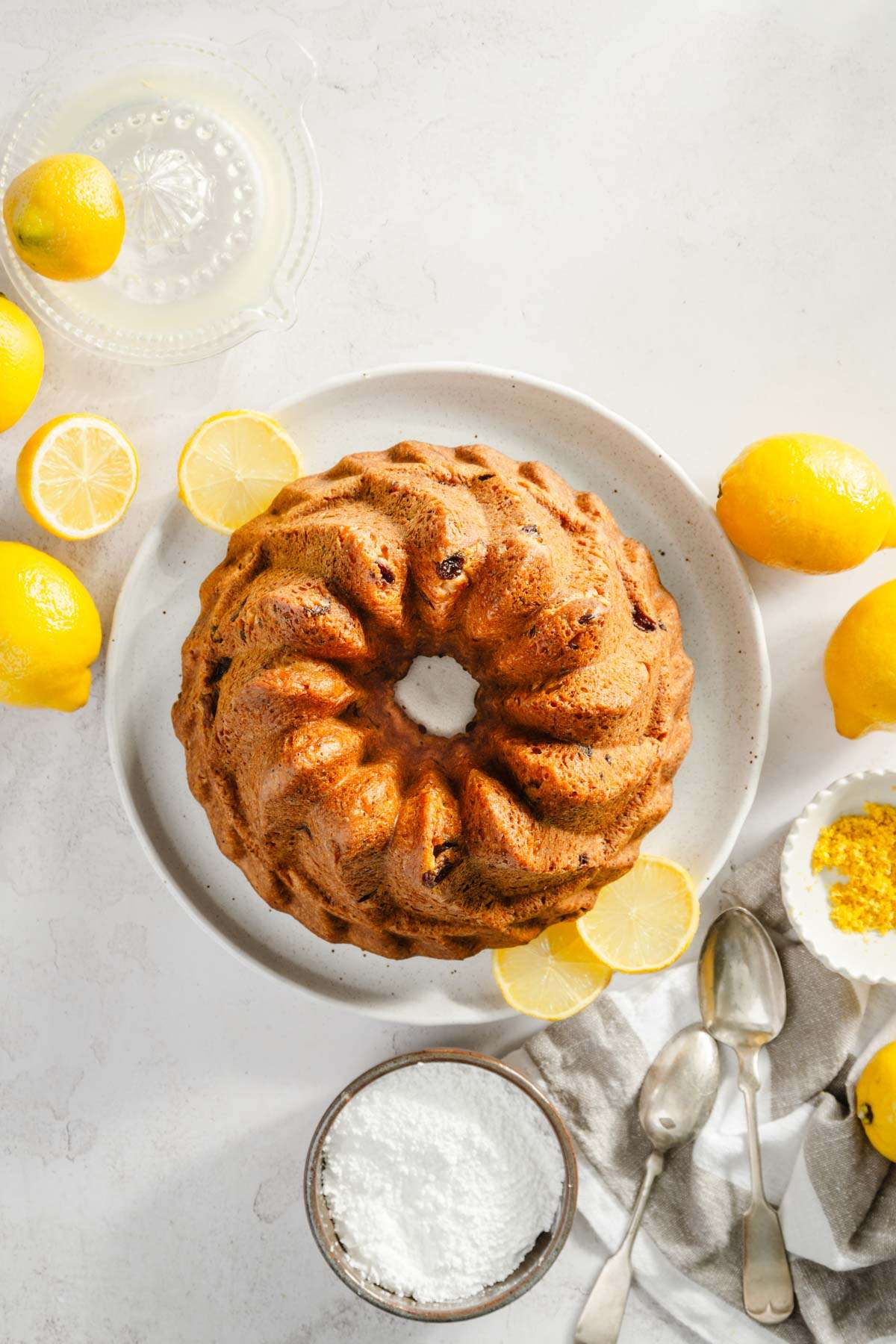
- Bake the babka – preheat oven to 350°F (175°C). Bake it in the preheated oven for 45-50 minutes, or until golden brown and cooked through.
- Remove the babka from the oven and let it cool completely in the baking form for about 10 – 15 minutes before transferring it to a wire rack to cool completely.
- Prepare the glaze – in a small bowl, whisk together powdered sugar, lemon juice, and additional lemon zest until the sugar dissolves and the glaze is smooth. If needed, adjust the consistency of the sugar mixture by adding water, a little at a time, until desired thickness is achieved.


You may also like

Storage and reheating instructions
Storage:
- Room Temperature – place Babka in an airtight container or wrap it tightly in plastic wrap to prevent it from drying out. Keep it in a cool, dry place away from direct sunlight. Consume within 2-3 days.
- Refrigerator – wrap Babka tightly in plastic wrap or place it in an airtight container to prevent it from absorbing any odors from the refrigerator. Babka stored in the refrigerator can last for up to one week.
- Freezer – for extended storage wrap it tightly in plastic wrap, followed by a layer of aluminum foil or place it in a freezer-safe bag to prevent freezer burn. Babka stored in the freezer can last for up to three months.
Reheating:
- Room Temperature – simply slice it and enjoy it as is. If it’s a bit dry, you can warm it slightly in the microwave or oven before serving.
- Refrigerator – If the babka has been refrigerated, allow it to come to room temperature before reheating.
- Freezer – If the babka has been frozen, thaw it in the refrigerator overnight. Once thawed, you can reheat it using one of the following methods:
- Microwave: Place individual slices of babka on a microwave-safe plate and microwave them on high for 20-30 seconds, or until warmed through.
- Oven: Preheat your oven to 350°F (175°C). Wrap the babka loosely in aluminum foil and place it on a baking sheet. Bake for 10-15 minutes, or until warmed through.
- Toaster Oven: If reheating individual slices, you can use a toaster oven. Place the slices on a baking sheet and toast them for 5-7 minutes, or until warmed through and slightly crispy on the edges.


Lemon – Poppy seed Polish Yeast Babka
Equipment
- mixing bowls
- measuring cups and spoons
- Babka baking form
- cooling rack
- Kitchen towel or plastic wrap
- Citrus zester
- stand mixer optional
Ingredients
For the Raisins
- 1 cup golden raisins
- ¼ cup rum or brandy
- 1 cup hot water
For the Yeast
- ¾ cup warm milk
- 3.5 tsp active dry yeast
- 2 tbsp sugar
For the Dough
- 4 cups flour
- ½ cup granulated sugar
- 1 tsp vanilla extract
- 5 egg yolks
- 1 whole egg
- 2 tbsp lemon zest
- 2 tbsp poppy seeds
- ½ tsp sea salt
- 150 g melted butter + more for greasing the pan
For the Glaze
- 1 cup powdered sugar
- 1 tbsp lemon juice + additional lemon zest
- Water if needed
Instructions
- Prepare the Raisin Filling – add golden raisins and brandy to a small bowl. Stir well to combine. Finish by pouring hot water to cover the raisins fully. Let the raisins soak for at least 30 minutes.
- Activate the Yeast – in a small bowl, combine warm milk, active dry yeast, and 1- 2 tablespoons of sugar. Stir gently to combine and let it sit in a warm place for about 5-10 minutes until the yeast becomes foamy and fragrant.
- Drain the soaked raisins, discarding any excess liquid. Pat the raisins dry with a paper towel and set them aside. I also sprinkled the raisins with tablespoon of flour to further absorb any moisture.
- Prepare the Dough – In a large mixing bowl combine together flour, egg yolks, whole egg, granulated sugar, vanilla extract, lemon zest, poppy seeds, sea salt, activated yeast, butter and raisins. Using your hands knead lightly to incorporate all the ingredients until soft dough forms.
- Knead the Dough – transfer the dough to a floured surface and knead it for about 10-15 minutes until it becomes smooth and elastic.
- Fill the Babka Form – grease the babka baking form with butter. Transfer the prepared dough into the greased baking form, spreading it out evenly.
- Let the Babka Rise – cover the babka with a clean kitchen towel or plastic wrap. Let the babka rise in a warm place for about 30-45 minutes, or until doubled in size.
- Bake the Babka – preheat your oven to 350°F (175°C). Bake it in the preheated oven for 45-50 minutes, or until golden brown and cooked through.
- Remove the babka from the oven and let it cool in the baking form for about 10 minutes before transferring it to a wire rack to cool completely.
- Prepare the Glaze – in a small bowl, whisk together powdered sugar, lemon juice, and additional lemon zest until smooth. If needed, adjust the consistency of the glaze by adding water, a little at a time, until desired thickness is achieved.
- Glaze the Babka – once the babka has cooled completely, drizzle the glaze over the top.
- Allow the glaze to set for a few minutes before slicing and serving.
Notes
Nutrition
Did you make this recipe?
Tag me @sylwiavaclavekphotography or tag me using #myomnikitchen so I can see your creations! You can also leave a comment below!
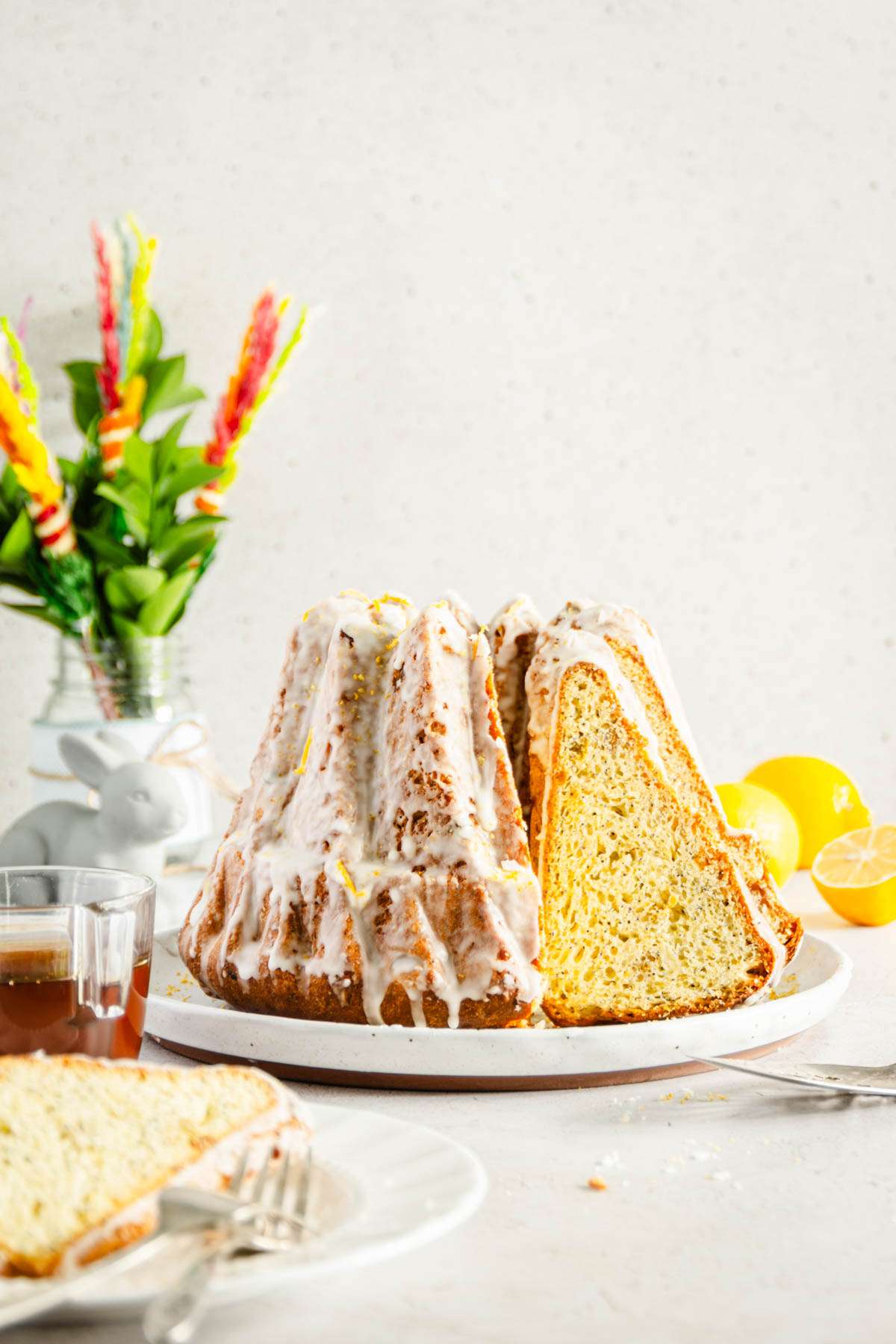
Conclusion
Whether you are looking for a Polish Easter babka or for Babka just because, I hope you love this recipe! I hope the 15 min kneading did not scare you and you will give this recipe a try. The dough being soft and flexible makes the kneading enjoyable. I know, I know this sounds weird, but it is true. Seeing and feeling the dough transform under your palms is very rewarding. Seeing and tasting the dough after you slice the Babka you realize every minute of the 15 minutes was worth it. Delicious, soft, buttery and a little tangy dough filled with plumped raisins and crunchy poppy seeds. You will be fighting for the last slice, guaranteed.
So what are you waiting for? Grab your bundt pan and get baking. You won’t be disappointed by this Polish Lemon Poppy seed Baka recipe.
FAQ about Babka
What is babka?
Babka is a traditional Eastern European cake with Jewish roots. Characteristic rich, sweet dough is typically twisted or braided. It often contains fillings such as raisins, chocolate, cinnamon, nuts, or fruit, resulting in a flavorful and indulgent treat.
Is babka a bread or a cake?
Babka is often described as a sweet bread due to its yeast-risen dough, but its rich and decadent texture leans more towards cake-like. It is a hybrid between bread and cake, offering a delightful combination of flavors and textures.
What does babka taste like?
Babka has a rich, buttery flavor with hints of sweetness from the dough and fillings. The taste can vary depending on the type of filling used, with options ranging from chocolate and cinnamon to fruit and nuts. Overall, babka is indulgent, moist, and satisfyingly sweet.
What are the different types of babka?
In Polish cuisine there are three types: Yeast Babka, Babka Piaskowa and Potato Babka. Each type offers a unique flavor profile and delicious texture. Babka Piaskowa, also known as a Sand Cake is made with a dense, buttery batter resembling a pound cake. This Babka gets its name from its crumbly, sand-like texture, which comes from the use of finely ground flour or semolina. Yeast Babka is made with a yeast-based dough, resulting in a soft, fluffy texture similar to bread. Potato babka, also known as babka ziemniaczana, is a traditional Polish dish that combines the earthy flavor of potatoes with the sweetness of sugar and the richness of butter. It’s made by mixing mashed potatoes into the dough, resulting in a moist and tender texture.
How do you pronounce “babka”?
The pronunciation of “babka” can vary depending on regional accents and language differences. In Polish, it’s pronounced as “bahb-kah.” In English, it’s commonly pronounced as “bahb-kuh” or “bab-kuh.”
Can babka be made ahead of time?
Yes, babka can be made ahead of time and stored for later consumption. It can be baked in advance and stored at room temperature, in the refrigerator, or even frozen for longer-term storage. Read more HERE about recommended storage methods.
What’s the best way to store babka?
The best way to store babka depends on how soon you plan to consume it. Babka can be stored at room temperature for a day or two if tightly wrapped in plastic wrap or stored in an airtight container. For longer storage, it’s best to refrigerate or freeze babka to maintain its freshness. Read more HERE about best storage options for Babka.
Can babka be frozen?
Yes, babka can be frozen for extended storage. Wrap it tightly in plastic wrap, foil, or place it in a freezer-safe bag to prevent freezer burn. When ready to enjoy, thaw the babka in the refrigerator overnight or at room temperature for a few hours.
What’s the difference between babka and krantz cake?
Babka and krantz cake are similar in appearance, both featuring twisted or braided dough with sweet fillings. However, they originate from different cultural traditions, with babka being Eastern European Jewish and krantz cake being Middle Eastern Jewish. Additionally, krantz cake often incorporates flavors like chocolate and cinnamon, while babka can have a wider variety of fillings.
Is babka traditionally served with anything?
Babka is often served as a standalone treat, enjoyed with a cup of coffee, tea, or hot chocolate. Some people also like to serve it with a dollop of whipped cream or a scoop of ice cream for added indulgence. It’s a versatile dessert that can be enjoyed on its own or paired with other beverages and toppings.
Can I use a loaf pan if I don’t have a bundt pan?
While the traditional shape of babka is typically more cylindrical, baking it in a loaf pan will still yield a delicious result. Using a loaf pan may result in a slightly different appearance than traditional babka, but the taste and texture will still be delicious







